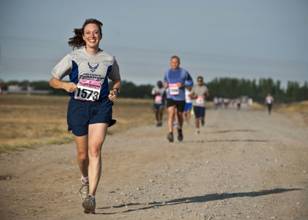Archives
Five Thing COPD Sufferers Should Know about Exercise
 It’s understandable why many people living with chronic obstructive pulmonary disease (COPD) are hesitant to exercise – they are challenged enough with their breathing. However, if done correctly, physical activity can improve COPD symptoms.
It’s understandable why many people living with chronic obstructive pulmonary disease (COPD) are hesitant to exercise – they are challenged enough with their breathing. However, if done correctly, physical activity can improve COPD symptoms.
“People with COPD have shortness of breath when they exercise,” says Daniel Ouellette, MD, a pulmonologist with the Henry Ford Health System in Michigan. “Exercise that involves aerobic activity, such as taking a walk or going to the gym, can provoke significant distress for people with COPD.”
He adds: “I try to reassure people that exercise is beneficial and that it will improve their ability to do things.”
In fact, it’s important for COPD sufferers to get some sort of aerobic exercise, which will help strengthen their heart and lungs. But when starting a new fitness regimen, they should proceed with caution and consider the following five things as they seek to break the potentially dangerous cycle of inactivity.
- Consult your doctor: People with COPD should be tested by a physician before starting any kind of physical regimen to ensure it is safe. Once cleared to begin exercising, it is a good idea to contact other specialists, such as a physical therapist, exercise physiologist and personal trainer, to develop a workout plan that meets your specific needs.
- Participate in pulmonary rehabilitation: These programs – including exercise, training, and support – help COPD patients better manage their symptoms and improve their quality of life. Because pulmonary rehabilitation is conducted in a safe and supervised setting, it is also a great way for COPD sufferers to develop confidence in their ability to exercise and be active.
- Take a walk: According to a study in the Journal of the COPD Foundation, people who walked 60 minutes per day reduced their COPD hospitalization rate by 50%. If you live someplace with extreme weather, try walking around a shopping mall or on a treadmill in a fitness center.
- Exercise puts your mind at ease: Robert Benzo, MD, a pulmonologist at Minnesota’s Mayo Clinic, notes that exercise is “a very good antidepressant,” especially for those dealing with a stressful condition like COPD. “People learn not only to move more,” he added, “but they learn to deal with their emotions as they move.”
- Resistance training helps: While aerobic exercise is great for the heart and lungs, resistance training with bands or weights to strengthen muscle is also important because COPD often causes loss of muscle strength or muscle mass.
Added Insights from Dr. Nair: This is extremely helpful information, particularly the discussion around hesitancy to exercise. As Dr. Ouellette notes, people with COPD get short of breath faster than before, which makes them less inclined to exercise. This leads to a vicious cycle of avoiding physical activity, so their bodies become deconditioned, which means they are even more likely to become short of breath and are more easily fatigued when they do attempt to exercise. Which feeds the hesitancy.
I also want to stress how important it is to consult with your doctor first in case they have any reservations about starting more vigorous activity. Other medical problems such as heart disease should also be considered.
Read the complete story on Everyday Health about the benefits of exercise for those living with COPD.
Maintaining Pulmonary Hygiene
 Pulmonary hygiene refers to exercises and procedures that can help people clear their airways of mucus and other secretions. These exercises can be extremely helpful to those suffering from chronic obstructive pulmonary disease (COPD).
Pulmonary hygiene refers to exercises and procedures that can help people clear their airways of mucus and other secretions. These exercises can be extremely helpful to those suffering from chronic obstructive pulmonary disease (COPD).
There are many methods and approaches to pulmonary hygiene, some of which can be done at home and others that require a visit to a healthcare provider.Here are some pulmonary hygiene activities and how you can get the best out of them.
- Breathing exercises — These exercises can relax airways after a coughing fit or help clear them without the need for a big cough. Two exercises that can help with pulmonary hygiene are relaxed breathing and huffing.
- Suctioning — In this method, a thin tube called a suctioning catheter is attached to a device that pulls air through a tube while the other end sucks secretions out of your airways. This procedure can be a little uncomfortable — but it only lasts about 15 seconds and you will get a break in between if you require more than one session.
- Spirometry — An incentive spirometer is a clear device with a flexible tube attached to it. At the other end is a mouthpiece for a person to inhale and exhale. A tiny ball or other indicator goes up and down inside the spirometer as you exhale. Your healthcare provider will explain how to use the device properly.
- Percussion — Also called clubbing or clapping, percussion can be done at home — but requires the help of another person to break up secretions in the lungs by striking your chest or back with cupped hands. This method should not be used on someone who is frail or dealing with sore ribs.
- Vibration — Similar to percussion, vibration can also break up lung secretions — but is done with flat palms instead of cupped hands. The person performing the procedure keeps one arm straight, with the palm of the hand on your chest or back. Then they place the other hand on top of the flat hand and move it rapidly from side to side to create a vibration.
- Postural drainage — This relies on gravity to clear out airways and can be performed in a number positions depending on what area needs to be cleared. To improve breathing in your lower lungs, for example, lie on your back with pillows underneath your hips.
Read the whole story to learn more about pulmonary hygiene.
Study Suggests that Physical Inactivity is as Dangerous as Smoking for Heart Disease, Stroke
 An extensive examination of an ethnically diverse sample of nearly 1 million Kaiser Permanente patients compared the individual contributions of significant risk factors for heart attacks and stroke and found physical inactivity carried a higher-than-expected risk.
An extensive examination of an ethnically diverse sample of nearly 1 million Kaiser Permanente patients compared the individual contributions of significant risk factors for heart attacks and stroke and found physical inactivity carried a higher-than-expected risk.
In the study, published in February 2020 in the European Journal of Preventive Cardiology, researchers compared six of the American Heart Association’s (AHA) “Simple 7” cardiovascular health risk factors to determine their relative associations with coronary heart disease and stroke in a large population.
“Heart disease remains the number 1 killer and stroke the number five killer in the United States,” said lead author Jamal S. Rana, MD, Ph.D., chief of cardiology at Kaiser Permanente Oakland Medical Center and adjunct researcher at the Kaiser Permanente Division of Research. “Lack of physical activity carries 65% excess risk, similar to that of smoking or poor cholesterol levels.”
Researchers examined the patients' blood pressure, smoking, physical activity, body mass index, total cholesterol, and blood glucose.
“It speaks to the strength of our integrated healthcare system that we were able to harness data from physical activity to laboratory blood tests to explore comparative risk at such a large scale," Dr. Rana said.
The excess health risk associated with physical inactivity ranged across ethnicities from 43% to 73% for combined heart disease and stroke. A recent Centers for Disease Control and Prevention estimate found that the percentage of Americans who are physically inactive ranges from 17% to 48%, depending on the state or territory where they live.
To learn more about the findings in the study, visit Kaiser Permanente’s site dedicated to the report’s findings.
Emphysema Patients Can Improve Their Exercise Capacity With New Implant
 If you or anyone you know are suffering from emphysema, you already know the toll it can take on your body and how difficult it can be to exercise, especially for long periods of time. But what if there was an implant device that would help you to increase your exercise level and decrease your symptoms of emphysema? Now, it’s possible.
If you or anyone you know are suffering from emphysema, you already know the toll it can take on your body and how difficult it can be to exercise, especially for long periods of time. But what if there was an implant device that would help you to increase your exercise level and decrease your symptoms of emphysema? Now, it’s possible.
In a recent study conducted at 10 university hospitals in France, it was found that individuals suffering from emphysema and other inflammatory lung diseases can partake in a “minimally invasive surgical intervention that could lead to significant improvements in exercise capacity. This technique involves fitting lungs with bilateral coils using an endoscope.”
This new form of precision medicine hopes to improve efficiency of technologic intervention and could serve to translate into greater cost-effectiveness for the treatment of emphysema.
With an estimated 4.1 million people in the United States living with emphysema, this treatment could prove to be a promising solution for those individuals looking to maintain a healthy, active lifestyle, while managing their symptoms without the use of medications.
The results of the study found that “patients in the coil group experienced substantial decreases in lung hyperinflation and improvements in quality of life.” The downside, however, is the current cost of the procedure, with patients in the coil group averaging “$47,908 more than the usual care group” in treatment cost. This increased cost does not mean that the treatment is not realistic though, as technology improves, study authors suspect that the cost will decrease and become more affordable.
Chinese Exercises, Breathing Patterns Aid COPD Patients
 For those living with chronic obstructive pulmonary disease (COPD), breathing is often cumbersome and labor-intensive. Even the most menial of activities can become difficult, but a traditional Chinese breathing exercise could make breathing that much easier.
For those living with chronic obstructive pulmonary disease (COPD), breathing is often cumbersome and labor-intensive. Even the most menial of activities can become difficult, but a traditional Chinese breathing exercise could make breathing that much easier.
Practiced by over 100 million people in China, the traditional Chinese breathing exercise, known as liuzijue qigong (LQG), uses a meditative movement of patterned exercise to create a state of “zen”. Much like yoga, a group of meditative movements popular in the U.S., LQG is helping people to improve and stabilize their breathing.
In a recent study conducted in Beijing, China, researchers used “126 COPD patients, aged between 65 and 85 years old to undergo a 45-minute LQG program, 4 times a week, along with daily walking for 30 minutes for 6 months”. Another group of participants (the control group) were instructed to only walk daily for 30 minutes.
The researchers found that “the LQG group exhibited significant improvements in their lung function, general health, mental health, and quality of life at the end of 6 months, compared to the COPD patients in the control group at only walked for 30 minutes a day”. The findings suggest that this traditional form of meditation and exercise may be greatly beneficial in rehabilitating older COPD patients, and may be used as a favorable alternative to regular exercise routines.
For those in the U.S. unfamiliar with LQG, yoga can be a similar alternative, although the results of the study did not test the results yoga has on COPD patients. To read the full study and learn more about LQG exercises. click here.
2-Mile Walk May Reduce Hospitalizations for COPD Patients
For chronic obstructive pulmonary disease (COPD) patients, walking at least two miles daily may reduce the risk of hospitalizations from severe episodes. That is according to a recent study published in the April 2014 issue of Respirology, “Influence of changes in physical activity on frequency of hospitalization in chronic obstructive pulmonary disease.”
The study, which examined the physical activity of more than 500 ambulatory clinic patients being treated for COPD, found that patients who had regular walking regimens between roughly two and four miles daily were half as likely to be hospitalized as those who did not walk regularly. These findings were calculated based on self-reported exercise totals from participants, the compared to data on hospitalization records. Patients’ activity was tracked for at least two years.
This study further confirms the importance of physical activity for people living with COPD and chronic lung conditions such as emphysema. While regular exercise may seem like a daunting task, slowly working up to a moderate level of activity can have positive long-term benefits. For those who find this difficult, walking with a family member or pet may prove helpful, as this will provide individuals with the motivation they need to complete their daily exercise goals.
"Of course, daily walking acts to improve the exercise capacity of these patients," said study author Dr. Cristobal Esteban, a staff member in the respiratory service at Hospital Galdakao-Usansolo in Spain, in an article published by Health Day. "Physical activity is a 'medicine' that will improve your general condition as well as COPD."
In-Home Exercises May Benefit Homebound COPD Patients
A pilot-study of chronic obstructive pulmonary disease (COPD) patients who meet the definition of homebound has found that just two months of aerobic conditioning and functional strength training can produce measurable improvements in quality of life. As defined by Medicare, homebound includes any person who is unable to leave the home without the help of an assistive device or another person. The study found that the greatest improvements in quality of life were seen in dyspnea and depression.
COPD Linked to Walking Problems
Chronic obstructive pulmonary disease (COPD) may cause abnormalities in patients’ muscular systems that affect the way they walk, according to recent research published in the journal of Respiratory Medicine.
In an effort to determine whether walking abnormalities are associated with COPD severity, researchers from the University of Nebraska and the University of Kentucky, examined data collected in the National Health and Nutritional Examination Survey (NHANES) to explore the association of COPD severity on gross walking abnormalities, including limping and shuffling. The date from the NHANES provides information from 31,000 people between the years 1988 and 1994. Logistic regression models were composed based on age, gender, body mass index (BMI) and smoking status as predictors of walking abnormalities and physical activity. The study looked specifically at the association of physical activity levels with COPD severity and walking abnormalities.
Researchers found that for patients between the ages of 40 and 90, there was a significant correlation between COPD severity and the risk of walking problems. Persons who with COPD had nearly double the risk of walking problems. Decreased physical activity was also significantly linked to all but mild levels of COPD, suggesting that disease severity can contribute to mechanical outcomes.
Researchers believe that the association between walking abnormalities and COPD may be due to the presence of physical inactivity in patients with COPD. Further, additional research should be conducted investigating more closely the mechanical outcomes of COPD patients.
Click here to access the full study from Respiratory Medicine
Cycling to Better Health
With the diagnosis of CPOD and associated breathing troubles, many patients often find that it is much more difficult to lead an active life. Difficulties with completely exhaling often mean the inability to stay active and physically fit.
Now, however, a series of studies from the Norwegian University of Science and Technology (NTNU) suggests that improving a patient’s overall fitness may actually improve their quality of life. Their solutions: additional oxygen during exercise or cycling on a stationary bicycle using just one leg at a time.
During exercise, the muscles place a demand on the lungs for oxygen, which in any other training environment would mean a positive workout. For COPD patients, however, the lungs may have such a difficult time providing the oxygen they need that the oxygen saturation in their blood may drop below 88%. By providing these patients with extra oxygen while they exercise, this crisis is averted and physical fitness can be achieved.
Participants in one study, who were given extra oxygen during exercise, demonstrated a 20% improvement in cardiovascular fitness after just 24 high-intensity training sessions. They also reported that their quality of life improved by 24% in terms of physical health status, and 35% in terms of mental health status.
By improving their fitness, COPD patients used less of their maximum capacity. That, in turn, made training less of an effort. Further, because the effort required to breathe was reduced, patients were less limited overall by CPOD.
For patients without access to oxygen during exercise, riding the bicycle one leg at a time is another solution. This approach maximizes the supply of oxygen to the muscles, while minimizing the effects of reduced lung capacity, essentially enabling the load on each leg to be increased without increasing the work the lungs must do. The results: a 12% increase in whole body fitness and 23% increase in workout rate.
Ultimately, by improving fitness levels, COPD patients are better able to participate in social life and perform everyday tasks. As a result, quality of life is improved. Full Story
COPD Patients May Benefit From Wii Fit Exercises
People with chronic obstructive pulmonary disease (COPD) may benefit from exercising with Nintendo’s Wii Fit video game, according to a recent study out of the University of Connecticut Health Center. That is because the video game may make working out more enjoyable for COPD patients and thus encourage the type of physical activities that help people with breathing problems.
Wii Fit, which has been marketed by Nintendo as a mixture of fitness and fun, allows users to view images on the television while standing on a sensitive board that sends electronic signals to the game console. The game offers exercises similar to those available in traditional rehabilitation centers; regular exercise using the game may increase COPD patients’ overall muscle tone and improve cardiopulmonary fitness.
The study examined five volunteers with stable COPD. Before exercising with the Wii, researchers performed tests to examine their top workloads and heart rates, plus oxygen consumption levels and other respiratory factors. Patients were then asked to run in place, do some upper arm exercises, step in place and maneuver on an obstacle course. Each exercise was done for three to five minutes, and then the researchers retested the patients.
When tested by researchers after the exercise routine, patient heart rate was at 71% of the maximum predicted value, while patient oxygen consumption was at 86% of the maximum predicted value. These numbers are strong considering most exercise programs aim to achieve between 60% and 80% of values to be safe and effective.
“Our study showed that COPD patients exercised at a relatively high percent of their maximum during three to five minutes of specified Wii Fit exercises, indicating the Wii Fit may be a reasonable home-based exercise regimen for COPD patients,” Jeffrey Albores, MD, of the University of Connecticut Health Center, said in a news release.
While results of the study are encouraging, researchers believe more research is needed to determine if Wii Fit increases a patient’s willingness to perform regular workouts at home.




